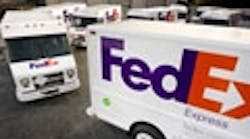FedEx Corp has added 92 hybrid-electric trucks to its delivery fleet—the first standard FedEx delivery trucks converted to hybrid-electric systems.
The addition of the 92 trucks increases the FedEx fleet of hybrid-electric vehicles by more than 50%, from 172 to 264.
In converting the standard delivery vehicles, the power-train equipment, including the engine, transmission, fuel tank and drive shaft, were replaced with a 2007 Cummins ISB 200 hp engine and Eaton hybrid-electric system. Costs were reduced by utilizing the existing chassis and body.
The vehicles feature a diesel engine coupled with an electric motor/generator and lithium-ion batteries. These batteries capture and store energy during the regenerative braking phase of vehicle operation, eliminating the need to plug into an electrical source. The sophisticated hybrid controller selects the most efficient mode of operation—diesel or electric—depending upon current operating conditions and driver demand.
The converted hybrids were developed with Freightliner Custom Chassis Corporation (FCCC) and Eaton Corporation, which provided the hybrid-electric systems. The standard FedEx trucks used in the retrofit program were 2000 or 2001 models with 300,000 to 500,000 miles driven. Converting used vehicles extends the life of the trucks.
“The conversion of these standard FedEx trucks into hybrids is the latest milestone in our drive to advance and adopt hybrid technology into our fleet and the broader industry,” said John Formisano, vice president, Global Vehicles, FedEx Express. “FedEx and our suppliers have demonstrated that converted hybrids are a viable, lower-cost option compared to purchasing new hybrids. We now need government incentives to end a Catch-22 situation: Production volumes are low due to high cost, and costs will only come down with higher production volumes.”
The retrofit hybrid trucks are projected to improve fuel economy by 44%, decrease particulate matter by 96% and reduce smog-causing (NOx) emissions by 75% compared to the standard FedEx Express delivery truck.
The 92 retrofitted hybrid vehicles will be placed into service in California, primarily in the Los Angeles, San Diego and San Francisco metropolitan areas.
The FedEx hybrid-electric fleet has logged more than four million miles of revenue service since being introduced in 2004, reducing fuel use by 150,000 gallons and carbon dioxide emissions by 1,521 metric tons, according to the company, equivalent to removing 279 cars from the road annually.
Formisano applauded the California government for continuing to provide incentive funding for hybrid truck purchases, which allowed FedEx to place its first hybrid truck into service in the state in 2004 and continue to add hybrids to its fleet during the past five years.
In addition to the use of these hybrid vehicles, FedEx has taken the following steps to increase vehicle fuel efficiency and reduce emissions in its fleet:
- Since 2005, FedEx has been rebalancing its fleet with smaller, more fuel efficient Sprinter vans and optimizing routes. As a result of these efforts, FedEx Express says it has saved 45 million gallons of fuel or 452,573 metric tons of carbon dioxide emissions.
- FedEx Ground is testing hybrid hydraulic technology with Parker Hannifin Corporation and FCCC on a heavier-class vehicle (Class 6).
- In London, FedEx operates liquid petroleum gas (LPG) Sprinter vans, which reduce carbon dioxide emissions by 12%. FedEx will also use 10 zero-emission Modec electric delivery vehicles in the United Kingdom.









